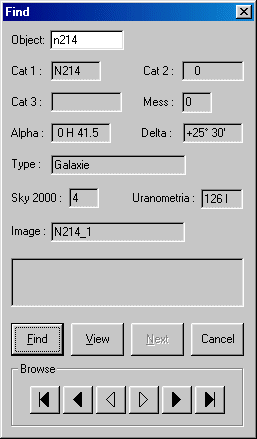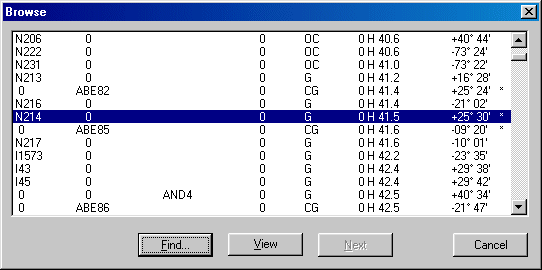
Buil-Thouvenot Atlas tutorial
The BT-Atlas version 3.0 is a unique collection of digital pictures representing some 6,580 deep-sky objects. These pictures were taken exclusively with CCD cameras with telescopes and refractors ranging from 50mm to 1000mm in diameter.
The BT-Atlas contains 4,638 16-bit images covering most types of deep-sky objects. Each type is represented by numerous examples. There are 4,991 individual galaxies, 284 galaxy clusters, 645 open clusters, 136 globular clusters, 155 planetary nebulae, 279 bright diffuse nebulae, and 90 dark nebulae. Many of these objects have never been seen by amateur astronomers (or even by most professionals). The BT-Atlas is the ideal tool for morphological studies of galaxies, or to prepare an observation, or to identify suspected supernovae.
Iris is a general purpose viewer for the BT-Atlas. Before using the program, you have to use the Settings command in the File menu. Type the letter of your CD-ROM unit in the CD-ROM field of the window (for example: D:). Then enter the path for the catalog files of the BT-Atlas, e.g. D:\CATALOG\.
Important: In order to increase search of objects, we suggest that you copy the entire CATALOG directory of the CD-ROM onto your hard drive, and then enter the new path in the BTA Menu.

Use the Find command (galaxy icon) in the tool bar to look for a given object. Enter the name of the object you are looking for. For example : N214, N 214, NGC214, M13, MESSIER13, ABE2218, HICKSON82, UGC10284, ARP91, PK2-52.1, PAL 12, BAR361... Then click on the View button to see the associated image. If more than one image from the object is available, the Next button will be activated.

To identify objects in the image, click the green H icon in the tool bar, or press the F4 key. Rectangles will be drawn on the image around ‘hot-spots’. Just click inside any rectangle to get the associated object name.
You may browse through the entire database by using the Browse command in the tool bar.

Click on table below to you display wide fields
cards (from the BT-Novae software) showing the distribution of the BT-Atlas
objects in the sky. The galaxies appear in red. The star clusters and nebulas
have respectively colors mallow and green.
Notice how the star clusters and nebulas are aligned along the Milky Way. Locate
also the great concentrations of galaxies in the Virgo region.
NGC 180
NGC 192
ARP 286
NGC 295
NGC 341 (ARP 59)
NGC 507
NGC 645
SCULPTOR
FORNAX
NGC 2274
M81
N3433
NGC 3877
ARP 194
NGC 3975
M63
NGC 6340
ARP320 (HICKSON
57)
ARP 34
ARP 314
NGC 7418
ABELL 194
ABELL 426
HICKSON 21
HICKSON 89
SH2-209
SH2-239
SH2-249
NGC 1544 (T TAURI)
NGC 2044 (TARENTULE)
HERBIG-HARO 1
HERBIG-HARO 249
NGC 2237
MESSIER 79
IC 4605
BARNARD 58
BARNARD 65
BARNARD 79
NGC 1528
IC 361
MESSIER 67
BERKELEY 68
MESSIER 11
BERKELEY 91
BASEL 15
NGC 6939
NGC 7063
NGC 6440
NGC 6441
MESSIER 10
MESSIER 12
MESSIER 53
How to order the Buil-Thouvenot Atlas
Order for US version: Sky Publishing Corp.
(Pour commander la version Française : Société d'Astronomie Populaire)